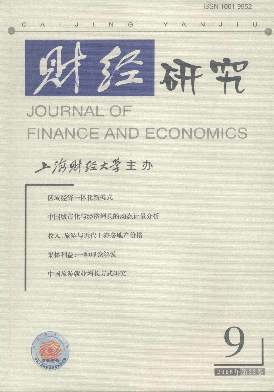区域经济一体化新模式——“轮轴—辐条”双边主义的理论与实证分析
财经研究 2006 年 第 32 卷第 09 期, 页码:5 - 19
摘要
参考文献
摘要
近年来区域经济一体化出现了一种新的模式,即“轮轴—辐条”(Hub&Spoke)双边主义,文章以古诺竞争模型为基础构建了包括轮轴国、辐条国、外部国家的n国厂商产业内贸易模型,指出“轮轴—辐条”模式的利益分配是极其不均衡的,与所有参与国成立自由贸易区相比,“轮轴—辐条”模式降低了成员国整体的福利水平。文章采用面板数据,利用扩展的引力方程对美洲地区已经形成的以墨西哥为轮轴的“轮轴—辐条”体系进行了回归检验,验证了所构建模型的理论。通过分析东亚一体化中可能形成的“轮轴—辐条”体系,指出目前中国应积极发展巩固自身的轮轴国地位,避免成为辐条国,然后逐渐以中国为轮轴的双边协定体系为基础,构建东亚自由贸易区。
[1]李向阳.新区域主义与大国战略[J].国际经济评论,2003,(7~8):5~9.
[2]Baldwin,Richard E.Towards an integrated Europe[R].London:CERP,1994.
[3]Baldwin,Richard E.The spoke trap:Hub and spoke bilateralism in East Asia[R].ht-tp://heiwww.unige.ch/~baldwin/papers/,2003.
[4]Benedictis L,Santis,R and Vicarelli C.Hub-and-spoke or else?Free trade agreementsin the enlarged EU:A gravity model estimate[J/OL].http://www.enepri.org,2005.
[5]Bhagwati J,Greenaway D,Panariya A.Trading preferentially:Theory and policy[J].The Economic Journal,Jul 1998,108(449):1128~1148.
[6]Bhagwati J.Free trade today[M].Princeton,NJ:Princeton University Press,2002.
[7]Conconi P.Strategic trade policy and the threat of regionalism[R].CSGR Working Pa-per No.73/01,2001.
[8]Deltas G,Desmet K,Facchini G.Hub-and-spoke free trade area[R].CERP,2005.
[9]Freund C.Different paths to free trade:The gains from regionalism[J].The QuaterlyJournal of Economics,2002,115(4):1317~1341.
[10]Inmaculada M,Z and Felicitas N L.Augmented gravity model:An empirical applica-tion to Mercosur-European Union Trade Flows[J].Journal of Applied Economics,Nov2003,(2):291~316.
[11]Kowalczyk C,R J Wonnacott.Hubs and spokes and free trade in the Americas[R].NBER Working Paper No.4198,1992.
[12]Lloyd P J,Maclaren D.Gains and losses from regional trading agreements:A survey[J].The Economic Record,2004,80(215):445~467.
[13]Pangariya A.Preferential trade liberalization:The traditional theory and new develop-ments[J].Journal of Economic Literature,2002,38(2):287~331.
[14]Perroni C,Whalley J.The new regionalism:Trade liberalization or insurance?[J].The Canadian Journal of Economics,2000,33(1):1~24.
[2]Baldwin,Richard E.Towards an integrated Europe[R].London:CERP,1994.
[3]Baldwin,Richard E.The spoke trap:Hub and spoke bilateralism in East Asia[R].ht-tp://heiwww.unige.ch/~baldwin/papers/,2003.
[4]Benedictis L,Santis,R and Vicarelli C.Hub-and-spoke or else?Free trade agreementsin the enlarged EU:A gravity model estimate[J/OL].http://www.enepri.org,2005.
[5]Bhagwati J,Greenaway D,Panariya A.Trading preferentially:Theory and policy[J].The Economic Journal,Jul 1998,108(449):1128~1148.
[6]Bhagwati J.Free trade today[M].Princeton,NJ:Princeton University Press,2002.
[7]Conconi P.Strategic trade policy and the threat of regionalism[R].CSGR Working Pa-per No.73/01,2001.
[8]Deltas G,Desmet K,Facchini G.Hub-and-spoke free trade area[R].CERP,2005.
[9]Freund C.Different paths to free trade:The gains from regionalism[J].The QuaterlyJournal of Economics,2002,115(4):1317~1341.
[10]Inmaculada M,Z and Felicitas N L.Augmented gravity model:An empirical applica-tion to Mercosur-European Union Trade Flows[J].Journal of Applied Economics,Nov2003,(2):291~316.
[11]Kowalczyk C,R J Wonnacott.Hubs and spokes and free trade in the Americas[R].NBER Working Paper No.4198,1992.
[12]Lloyd P J,Maclaren D.Gains and losses from regional trading agreements:A survey[J].The Economic Record,2004,80(215):445~467.
[13]Pangariya A.Preferential trade liberalization:The traditional theory and new develop-ments[J].Journal of Economic Literature,2002,38(2):287~331.
[14]Perroni C,Whalley J.The new regionalism:Trade liberalization or insurance?[J].The Canadian Journal of Economics,2000,33(1):1~24.
引用本文
东艳. 区域经济一体化新模式——“轮轴—辐条”双边主义的理论与实证分析[J]. 财经研究, 2006, 32(9): 5–19.
导出参考文献,格式为:
上一篇:劳动力转移、产业集聚与地区差距





 8533
8533  5506
5506

